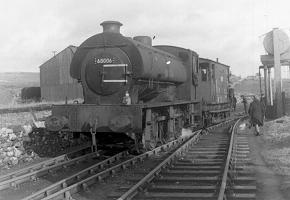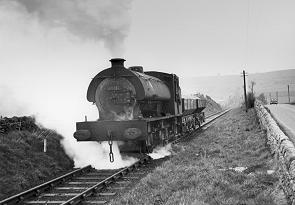Part 3 - A journey along the Cromford and High Peak Railway
 |
Arriving at around 10am the locomotive (J94 0-6-0 saddletanks 68012 in April 1966 and 68006 in January 1967) would be found "brewing up" at the entrance to the Middleton Top depot, and then would move off to be filled with water at the tower. (On the 1967 visit the unusually dry winter had caused a water shortage and almost cancelled the trip!) The Middleton Top area would then be shunted to collect the limestone wagons from the nearby quarry and water tender to be taken to Buxton. With no urgency the short train would start from Middleton Top at around 11am, with the students crammed into the brake van at the back. |
As the organiser of the tours I was privileged to travel in the cab of the locomotive particularly over the spectacular section from Middleton to the top of the Hopton Incline (6); a fantastic experience. Shortly after leaving Middleton the 113 yard limestone tunnel at Hopton (5) was passed, and the train would pause to uncouple the wagons to allow for the attack on the Hopton Incline, usually with only 2 (but up to 4) wagons at a time. From the bottom, the 457 yard incline was frightening to behold, with gradients increasing from 1 in 60 to 1 in 30 to 1 in 20, and for 200 yards the famous pitch of 1 in 14. |
 |
 |
In winter the incline track could be icy, and slippery! The locomotive would approach the incline at a steady speed of around 30 mph, which on the ascent would rapidly slow to a crawl. In the cab the driver would have to make careful use of the regulator to prevent wheel slipping, whilst the fireman worked the sanders. The slow and noisy progress up the incline would allow the fireman to step off the locomotive and apply sand from the sandbox directly onto the line. The driver would look anxiously out of the cab for "the point of no return" on the 1 in 14. If grip could not be obtained then the wagons could be pinned down and braked by the guard who travelled in the cab up the incline. The loco could then be uncoupled to continue up the incline to "dry the line" and then return to try again! |
In winter the exposed line could suffer from high winds and the locomotives had unusual wooden shutters fitted on the cab sides that could be closed over the cab entrance to keep out the cold.